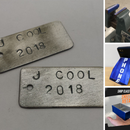Introduction: Quick, Easy Marker Holder
My dry erase markers in my classrooms never work. I go to the white board, pick up a marker from the tray, start to write, and the marker just doesn't work. I have taken to keeping most of my markers in a cup on my desk where I can keep the markers stored vertically. But out of habit I still always look for markers in the tray on the whiteboard instead of the cup on my desk. Finally I had had enough, I remembered I have lots of tools in my shop to make my own marker holders, so I quit complaining and got to designing.
These marker holders only take about 20 minutes to make if you design them from scratch, even less if you just use the files attached in the Instructable.
If you too constantly need better working markers at your whiteboard follow along, I'm going to walk you through how to make a quick, easy marker holder.
Step 1: Tools and Materials
Tools
- Measuring Device
- Heat source to bend plastic
- Laser Cuter
Materials
- Plastic (I used 1/8 acrylic sheets)
- Magnets
- Glue
Step 2: Measure Markers
Grab your markers and take measurements from them that will help you create your design. I used a dial caliper to take my measurements, but a ruler would have worked just as well. There are two main criteria I wanted in my finished marker holder. I wanted my markers to be stored vertically with the tip facing down and I didn't want the markers to wobble around in the holder. I took measurements from my markers that I thought I would need to design my holder to do those two things. The first measurement I took was the largest diameter of the cap. I need that measurement to make sure the hole in the top of the holder is large enough for the cap to fit through. Because, I also want my markers to fit snugly into the holder I made sure to get the largest diameter of the marker as well. I will need to make the size of the hole in the top larger than the cap but smaller than the largest diameter of the marker.
I then went on to take measurements from several other spots along the marker and cap that I thought I might need when I started designing.
After measuring one of my markers, I realized I have two different brands/styles of markers in my classrooms. I took the same measurements off the other style of marker so I could make my holder work no matter which brand I have at a particular whiteboard.
Steps to follow if you want to design your own:
- Measure and record several spots from the cap
- Measure and record several spots from the marker
Step 3: Design
Use the measurements you took from your markers to design your holder. I thought the design of my holder would be pretty simple, so I took the opportunity to better learn how to use Autodesk Inventor's sheet metal modeling tools. I don't have much experience with the sheet metal commands in Inventor; but I knew once I had a 3D model I could use the "Create a Flat Pattern" command to export a file that I could use in my laser cutter. Even without much experience with that specific set of commands I was able to create this model in about five minutes. If you have no Inventor or CAD experience it will take you a little longer but if you keep your design simple enough it probably won't take you too long to make. Once I had the model made and a flat pattern created I exported the pattern and the top face of my model as DXF files which I'll use with my laser cutter.
I've detailed the steps I took to make my model in the pictures.
I exported the top face so I could cut it out of plastic by itself. This piece will be glued to the inside bottom of the holder to keep the caps in place and stop the markers from slipping out of the holder.
Steps to follow if you want to design your own:
- Use your measurements to design your holder in a CAD software.
- Export your design to a format you can use with your laser cutter.
Step 4: Cut
Import the layouts of your design into your laser cutter software. Edit your imported design so it will work with your laser cutter and so it will cut out the way you want. In my laser cutter software I needed to make all of my cut lines red and any line I wanted engraved needed to be blue or black. The two lines in the center of my layout will be bend lines that I wanted to engrave onto my plastic. I used the engraved line as a visual cue to where I need to have my plastic lined up over my heating strip to help bend my plastic.
Once the parts are cut and removed from the laser cutter you are ready to bend.
I've attached the DXF files that I used. Feel free to use the design as is or edit them for your own requirements.
Steps to follow if you want to design your own:
- Import your design into your laser cutter software.
- If needed edit your design to work with your laser cutter.
- Run your laser cutter to cut your parts from your plastic.
Step 5: Bend
If you have a heating strip to bend your plastic this step is pretty straight forward. If you don't have a heating strip there are several other methods you can use to bend your plastic, a simple Google search can help you find a method that may work for you.
All of the bends should be at 90 degrees. Place the plastic over your heating strip where you want your bend to be. The plastic will take a minute or two to heat up enough to allow bending. Let the plastic heat up enough that it bends very easily, if you rush the bending before your plastic is properly heated your plastic will break or split at the bend. I start to bend the plastic on the heating strip but then move my part to the table to help get the 90 degree bend I want. You will have to hold your plastic at the angle you want for a few seconds to allow the plastic to cool and hold its new form. Once you have one side bent repeat the same process on the other side of my part.
Steps to follow if you want to design your own:
- Place your plastic over your heating strip where you need to bend.
- Wait for your plastic to properly heat up, so it is very easy to bend.
- Bend your plastic to 90 degrees.
- Hold your plastic at needed angle and wait for it to cool and hold its form.
- Repeat steps 1-3 for the other end of your marker holder.
Step 6: Assemble
With the main portion of the marker holder ready the next step is gluing. I used super glue to attach the bottom cap holder to the inside bottom of the marker holder. If you line up the corners of both of your parts when gluing; the holes on the top and bottom of the holder should be properly lined up. To keep the marker holder on my white boards I glued magnets onto the back. Be sure your magnets' magnetic forces don't oppose each other before you glue them on. On one of m marker holders I had a couple of magnets that did oppose each other and it would not hold very well onto my white board unless it was sitting right on top the tray.
Once the glue is dried on your magnets take your holder to your white board and try it out.
Steps to follow if you want to design your own:
- Clean off any dust from the areas where you will be gluing.
- Apply glue to any additional parts you will be attaching to your holder.
- Place your parts on your holder and hold them in place until your glue dries.
Step 7: Never Have Sucky Markers Again!
Voila! Quick, easy marker holders!
I've been using these holders on my whiteboards for a couple of weeks now and they are awesome! I haven't had a dry, unusable marker since I've made them which is pretty great in my book. The magnets I had in my room aren't the strongest so if I have the marker holders positioned up very high they will occasionally slide down the board, but that is not a huge issue for me. Overall I'm pleased with how these turned out and glad I don't have to worry about sucky markers anymore.
If you end up making some, let me know!
Enjoying building, and learning!







